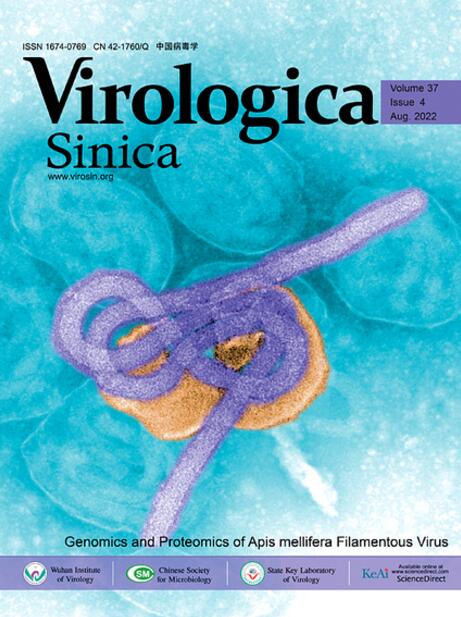Identification of PEDV inhibitors targeting 3CL protease
IF 4
3区 医学
Q1 Medicine
引用次数: 0
Abstract
Porcine epidemic diarrhea (PED), caused by porcine epidemic diarrhea virus (PEDV), is a highly contagious gastrointestinal disease characterized by vomiting, diarrhea, and dehydration, with mortality rates approaching 100% among suckling piglets. The PEDV 3C-like protease (3CLpro) is essential for viral replication and regarded as a critical target for antiviral inhibitor development. In this study, we aimed to identify small-molecule inhibitors of PEDV by targeting 3CLpro. Virtual screening of 1.6 million compounds from the ChemDiv library identified four potential candidates. Molecular dynamics simulations, specifically analyzing RMSD, RMSF, and Rg, demonstrated increased structural stability of the compound-protease complexes compared to the monomeric enzyme. All compounds had low cytotoxicity in Vero cells (CC50 > 200 μM). Fluorescence resonance energy transfer-based assays demonstrated dose-dependent inhibitory activity of the compounds against 3CLpro. Among the candidates, compound F366-0161 exhibited the weakest inhibition, with an IC50 value of 151.5 μM. Two analogues, 3238-0395 (IC50 of 121.4 μM) and L878-0493 (IC50 of 123.6 μM), exhibited moderately enhanced activity. Y041-1672 was identified as the most effective inhibitor, with an IC50 of 86.48 μM. In viral replication inhibition assays, Y041-1672 reduced PEDV replication, with an EC50 of 17.97 μM and a selectivity index (SI) of 15.5 (CC50/EC50). These results were validated by RT-qPCR, plaque assays, immunofluorescence, and Western blot analyses. In vitro validation confirmed Y041-1672 as the optimal antiviral candidate, and time-of-addition experiments indicated that inhibition primarily occurred during viral replication. This study identifies scaffold molecules for PEDV antiviral drug development, providing strategic insights for PED treatment.
靶向3CL蛋白酶的PEDV抑制剂的鉴定。
猪流行性腹泻(PED)是由猪流行性腹泻病毒(PEDV)引起的一种以呕吐、腹泻和脱水为特征的高度传染性胃肠道疾病,在哺乳仔猪中死亡率接近100%。PEDV 3c样蛋白酶(3CLpro)对病毒复制至关重要,被认为是抗病毒抑制剂开发的关键靶点。在本研究中,我们旨在以3CLpro为靶点,鉴定PEDV的小分子抑制剂。对ChemDiv文库中的160万种化合物进行虚拟筛选,确定了四种潜在的候选化合物。分子动力学模拟(RMSD, RMSF, Rg)表明,与单体酶相比,复合蛋白酶复合物的结构稳定性增强。所有化合物在Vero细胞中具有较低的细胞毒性(CC50 ~ 200 μM)。基于荧光共振能量转移的分析显示化合物对3CLpro的抑制活性呈剂量依赖性。其中化合物F366-0161的抑制作用最弱,IC50值为151.5 μM。两个类似物3238-0395 (IC50为121.4 μM)和L878-0493 (IC50为123.6 μM)表现出适度增强的活性。Y041-1672是最有效的抑制剂,IC50为86.48 μM。在病毒复制抑制实验中,Y041-1672降低PEDV复制,EC50为17.97 μM,选择性指数(SI)为15.5 (CC50/EC50)。这些结果通过RT-qPCR、斑块分析、免疫荧光和Western blot分析得到验证。体外验证证实Y041-1672是最佳抗病毒候选,添加时间实验表明抑制主要发生在病毒复制过程中。本研究确定了用于PEDV抗病毒药物开发的支架分子,为PED治疗提供了战略见解。
本文章由计算机程序翻译,如有差异,请以英文原文为准。
求助全文
约1分钟内获得全文
求助全文
来源期刊

Virologica Sinica
Biochemistry, Genetics and Molecular Biology-Molecular Medicine
CiteScore
7.70
自引率
1.80%
发文量
3149
期刊介绍:
Virologica Sinica is an international journal which aims at presenting the cutting-edge research on viruses all over the world. The journal publishes peer-reviewed original research articles, reviews, and letters to the editor, to encompass the latest developments in all branches of virology, including research on animal, plant and microbe viruses. The journal welcomes articles on virus discovery and characterization, viral epidemiology, viral pathogenesis, virus-host interaction, vaccine development, antiviral agents and therapies, and virus related bio-techniques. Virologica Sinica, the official journal of Chinese Society for Microbiology, will serve as a platform for the communication and exchange of academic information and ideas in an international context.
Electronic ISSN: 1995-820X; Print ISSN: 1674-0769
 求助内容:
求助内容: 应助结果提醒方式:
应助结果提醒方式:


